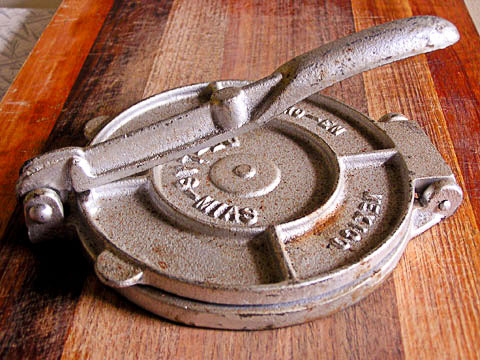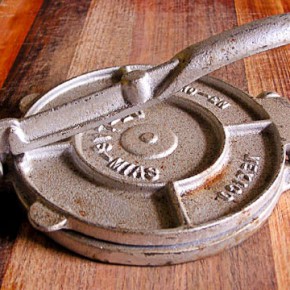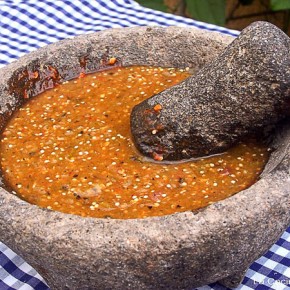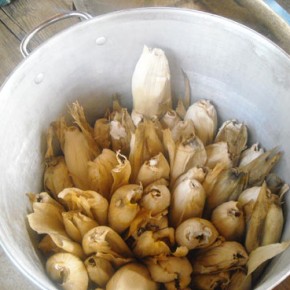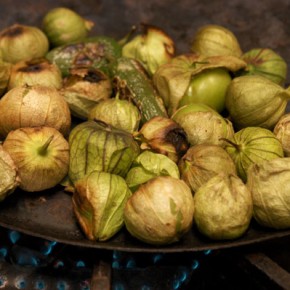When I first stepped foot into my new, fully equipped kitchen in Mexico, I found myself wondering “what the heck is this stuff?” – a surprise for me, having years of experience working in kitchens. After living in Mexico and serving Mexican- international fusion food, I’ve come to love these Mexican tools.
For anyone interested in delving into the art of authentic Mexican cuisine, here are some must-have tools:
Comal
The comal is a flat skillet or griddle, made out of steel, aluminum, clay, or cast iron. Every kitchen in Mexico will have at least one comal. The skillet is used to make the daily stack of fresh corn tortillas, to roast vegetables for a salsa or chiles rellenos (stuffed peppers), or to toast seeds that will be ground up into sauces. A cook never uses oil with the comal; it is meant for exclusively dry cooking and roasting.
Lime Juicer
A lime juicer, or exprimador de limón, is an incredibly handy gadget used to quickly squeeze juice out of limes or other citrus fruits. Since nearly all Mexican food (including fruit cups) are only deemed acceptable with a squeeze of lime, these hand held lime juicers are very important! Unlike the limes sold in large USA supermarkets, limes and lemons sold in Mexico contain lots of seeds. For cooks who want to add a splash of lime to their dish, painstakingly removing seeds first can get time consuming.
Limes in Mexico are also much smaller than the limes found in the United States., so if you want to purchase a lime juicer online be sure to get the correct size. The limes in the United States won’t fit into the small lime juicer, but do fine in a hand juicer meant for oranges. If you are using a hand juicer for the first time, make sure you position the fruit correctly; nearly all people who aren’t used to this tool place the fruit skin-side down. The halved citrus should be placed flesh side down to most easily extract the juice.
Molcajete and Tejolote
Molcajete and tejolote translate to mortar and pestle: these are one of the oldest traditional tools in Mexican cooking. Molcajetes are made from volcanic rock called basalt, making them very porous and rough. They are perfect for hand-grinding salsas and sauces and very much give a different, more exciting taste to the dishes they are a part of. A lot of people will attest that a salsa made using a molcajete tastes significantly better than one processed through a blender.
For those interested in buying a molcajete and tejolote, check a Mexican supermarket and ask around. Having them shipped from Mexico can be expensive because they are so heavy. The best way is to visit Mexico to purchase one for your home! Beware of the fake molcajete; be sure to get one that is made of basalt rather than a concrete mix. The molcajete needs to be seasoned before use. Grind handfuls of rice repeatedly until no grey fragments of the tool show up in your ground rice. Then you know it is ready to use.
Tortilla Press
A tortilla press, or una máquina para hacer tortillas, is a common tool especially found in the rural Mexican kitchen. While cities are full of stores that crank out thousands of corn tortillas a day – women living in rural areas make their own fresh tortillas three to seven times a week. Some older señoras still hand form their tortillas by slapping the masa (corn dough) with their hands to form a perfect, thin circle that is placed on a hot comal. Nowadays women use a tortilla press: a wooden or metal simple machine that presses a ball of masa into a circle, or an oblong shape for making a stuffed tortilla.
If you like to cook and you’ve ever had the pleasure of tasting a fresh corn tortilla hot off the griddle, then you will love using a tortilla press. The tortilla press makes homemade corn tortillas an easy option, and a fun food to share with friends. At the Bosque Village in Michoacán, visitors frequently learn how to make fresh corn tortillas and eat them with freshly ground salsa – right out of the molcajete.
Cooks usually place two thin sheets of waxed paper or plastic between the wood or metal and the masa. This keeps the dough from sticking to the machine. Wheat tortillas are made using a rolling pin, rather than a tortilla press.
Tamale Steamer
The tamalera is a pot especially designed for making batches of tamales: the famous, corn based dumplings steamed to perfection inside of a corn or banana leaf. A tamalera is not an essential item for making Mexican food; in fact, it isn’t even an essential item for making tamales (nearly any steamer will do). However, the two-part pot can be used for steaming vegetables and meats aside from tamal making. Tamaleras are big, easy to use, and a fun, inexpensive addition to any kitchen.
The tamalera is essentially a huge, tall pot with a ridge about 2-5 inches from the bottom that holds an aluminum plate perforated with holes. Water is heated below the plate, and tamales or whatever ingredients are stacked on top of the plate to be steamed. Take care not to let the water run out or you risk burning the ingredients and the pot. Some cooks add a coin to the water that will move about, making noise as the water boils. My friends prefer to use a U.S. penny because of the weight of the coin. If the noise stops: add water!
Molinillo
The molinillo, or wooden whisk, is a tool that perplexed me until about a year into my time in Mexico when I finally learned its purpose: to whip up that delicious Mexican hot chocolate into the frothy, foamy beverage that is so beloved by those who drink it.To use a molinillo, place the handle between your palms and rotate the handle rapidly by rubbing your hands together. This motion will allow the molinillo to aerate the beverage, creating a foamy drink.
Besides hot chocolate, molinillos are used to make atole: a corn or oat based creamy hot drink.
Metate
One of Mexico’s oldest traditional tools. Like the molcajete, metates are made out of volcanic rock. They are long, slightly curved surfaces that are used along with a mano – a hunk of the rock held in the hands to aid in grinding corn or other grains.
Grinding grains using a metate is very laborious, and the practice of hand-grinding is dying out as villages across Mexico employ newer machinery. Hand-cranked grinders are available in most hardware stores. Additionally, most women who want to grind their own corn have access to a molino – an electric grinder typically used by either a neighborhood or shared by an entire village.
Blender
Blenders, or liquidoras, are an essential tool in the modern Mexican kitchen. For those who don’t have time to use a molcajete to hand grind salsas, a blender makes a quick, tasty salsa in seconds. Blenders are also used to prepare aguas frescas – sweet water drinks mixed with fresh fruit and sugar. In an active kitchen, the blender is used daily to assist in meal and snack preparations.
- Tortilla Press, Photo by Phil Lees.
- Molcajete. Photo by Pily Guzman.
- Tamalera filled with tamales. Photo by Marie Oaks.
- Comal with roasted tomatillos. Photo by Marie Oaks.
- Metate. Photo by Samuel Ortega Torres.

